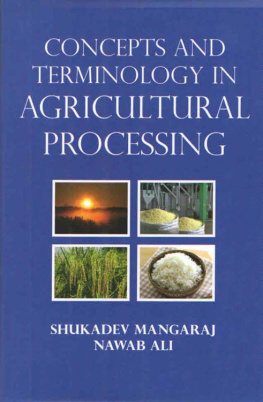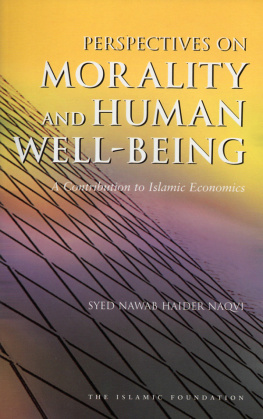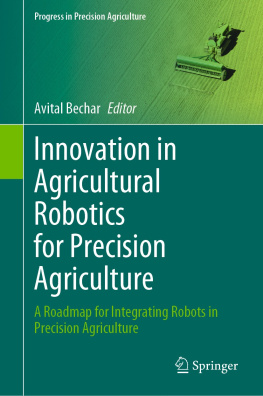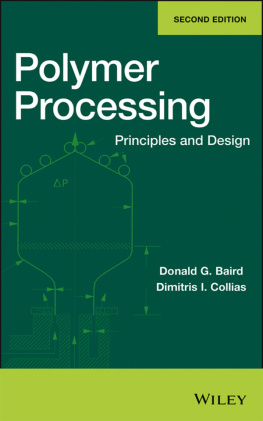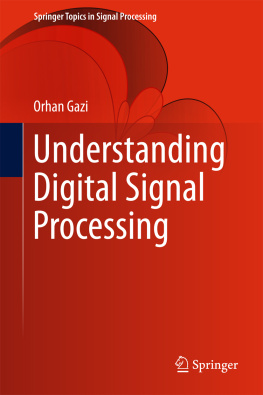Acknowledgement
The authors wishes to express their sincere thanks and gratitudes to various institutions, universities and organizations where they earned their academic degrees and acquired professional knowledge and skill in the discipline of agricultural and food engineering with specialization in agricultural processing and also to those scientists and engineers whose published works have been used in the book and duly listed in the bibliography.
Shukadev Mangaraj
Nawab Ali
Appendices
Appendix-l
Units and Measurements
The International System of Units (SI) is the metric system devised around the number ten. It is the worlds most widely used system of measurement both in everyday commerce and in science.
The older metric system included several group of units. The SI was developed in 1960 from the old metre-kilogram-second system. Because the SI is not static, units are created and definitions are modified through international agreement among many nations as the technology of measurement progresses, and as the precision of measurement improves. The system is nearly universally employed. Three principal exception are Burma (Myanmar), Liberia, and the United states. The United Kingdom has officially adopted the International System of Units but not with the intention of replacing customary measures entirely. There are seven base units of the SI
METRE (m) : The meter is the length of the path travelled by light in vacuum during a time interval of 1/299 729 458 of a second.
KILOGRAM (kg) : The Kilogram is the unit of mass; it is equal to the mass of the international prototype of the kilogram.
SECOND(s) : The second is the duration of 9 192 631 770 periods of the radiation corresponding to the transition between the two hyperfine levels of the ground state of the caesium 133 atom.
AMPERE (A) : The ampere is that constant current which, if maintained in two straight parallel conductors of infinite length,
of negligible circular cross-section, and placed 1 m apart in vacuum, would produce between these conductors a force equal to 2 x 107 Newton per meter of length.
KELVIN (K) : The Kelvin unit of thermodynamic temperature is the fraction 1/273.16 of the thermodynamic of the triple point of water.
MOLE (mol) : The mole is amount of substance of system which contains as many elementary entities as there are atoms in 0.012 kilogram of carbon 12.
CANDELA(cd) : The candela is the luminous intensity, in a given direction, of a source that emits monochromatic radiation of frequency 540 x 1012 hertz and that has a radiant intensity in that direction of 1/683 watt per steradian.
A prefix may be added to a unit to produce a multiple of the original unit. All multiples are integer powers of ten as shown in Table Al.
Table A1 : Prefix, sysmbol and multiplying factor of units
| Prefix | Symbol | Multiplying factor |
| Yotta | Y | 1 000 000 000 000 000 000 000 000 = 1024 |
| Zetta | Z | 1 000 000 000 000 000 000 000 = 1021 |
| Exa | E | 1 000 000 000 000 000 000 = 1018 |
| Peta | P | 1 000 000 000 000 000 = 1015 |
| Tera | T | 1 000 000 000 000 = 1012 |
| Giga | G | 1 000 000 000 = 109 |
| Mega | M | 1 000 000 = 106 |
| Kilo | k | 1 000 103 |
| Hecto | h | 100 = 102 |
| deka | da | 10 = 101 |
| deci | d | 0.1 = 10 -1 |
| centi | c | 0.01 = 102 |
| milli | m | 0.001 = 103 |
| micro | M- | 0.000 001 = 106 |
| nano | N | 0.000 000 001 = 109 |
| piko | P | 0.000 000 000 001 = 1012 |
| femto | f | 0.000 000 000 000 001 = 1015 |
| Atto | a | 0.000 000 000 000 000 001 = 1018 |
| zepto | z | 0.000 000 000 000 000 000 001 = 1021 |
| yocto | y | 0.000 000 000 000 000 000 000 001 = 1024 |
Appendix-2
Comparison of Thermometer Readings
| Centigrade | Fahrenheit | Centigrade | Fahrenheit |
| 40 | 40.0 |
| -36 | -32.8 | 32 | 89.6 |
| -32 | -25.6 | 36 | 96.8 |
| -28 | -18.4 | 40 | 104.0 |
| -24 | -11.2 | 44 | 118.4 |
| -20 | 4.0 | 48 | 125.6 |
| -16 | +3.2 | 52 | 132.8 |
| -12 | 10.4 | 56 | 140.0 |
| -8 | 17.6 | 60 | 147.2 |
| 4 | 24.8 | 64 | 154.4 |
| 0 | 32.0 | 68 | 161.8 |
| 4 | 39.2 | 72 | 168.8 |
| 8 | 46.4 | 80 | 176.0 |
| 12 | 53.6 | 84 | 183.2 |
| 16 | 60.8 | 88 | 190.4 |
| 20 | 68.0 | 92 | 197.6 |
| 24 | 75.2 | 96 | 204.8 |
| 28 | 82.4 | 100 | 212.0 |

Bibliography
Abdel-Bary EM. (2003). Handbook of plastic films. Rapra Technology Ltd., Shawbury, Shrewbury, Shropshri, SY4 4NR, UK.
Adams MR. (1990). Topical aspects of fermented foods. Trends in Food Science & Technology 1: 141- 144.
Aguilere J.M and Stanley D.W. (1999). Microstructural Principles of Food Processing and Engineering, 2nd Edition. Gaithersburg, MD: Aspen Publishing.
Alam A and Singh Gyanendra. (2003). Status and future needs of farm mechanization and agro-processing in India. Technical Bulletin CIAE/2003/96. Central Institute of Agricultural Engineering, Bhopal.
Alam A. (1980). Engineering properties of food materials (Technical Bulletin CIAE/80/15), PHTS, CIAE, Bhopal. (Compiled: Singh BP N; Sah PC; Tikoo AK).
Albright, L.D. (1990). Environment Control for Animal and Plants. ASAE Textbook. St. Joseph, Mich. : ASAE.
Ali, Nawab and Srivastava PK. (1993). Conditioning storage and milling of foodgrains and oilseeds. AET 17 (3-4): 1-18.
Ali, Nawab. (1998). Role of post-harvest technology and food processing in enhancing per capita food and fibre availability. Published in SOUVENIR of 33rd Annual Convention of ISAE held at CIAE, Bhopal, India during 21-23 September.
Ali, M. (2004). Nutritional Bible. Vermilion Publisher, London, UK.
Ali, N. (2005). Role of agricultural engineering towards food, nutritional and environmental security in India. Agricultural Engineering Today, Vol 29 (5-6): 1-11.
Ali, Nawab. (2011). Human evolution and Food Processing. Processed Food Industry. 14 (5): 21-25.
Ali, Nawab. (2013). Sustainable Agricultural Production for food and nutritional security. Indian Farming. 63 (7):58-66.
Ali Nawab and Mangaraj, S. (2014). Principles and Practices of Agricultural Processing. Satish Serial Publishing House, New Delhi. ISBN : 978-93-81226-94-0, Total Page 542.
Anon (2010). Introduction to Food and Food Processing (Training Manual for Food Safety Regulators). Vol. -I. Food Safety and Standard Authority of India, Ministry of Health and Family Welfare, New Delhi. Website: www.fssai.gov.in
ASHRAE. 1993. Handbook of Fundamentals, Chapter 30: Thermal properties of food. ASHRAE, Atlanta, GA.
Bakker-Arkema, Fred W. (1999). CIGR Handbook of Agricultural Engineering: Agro-processing engineering/vil. ed.: F. W. Bakker-Arkema, Volume 4. American Society of Agricultural Engineering, Total pages: 527.
Next page
